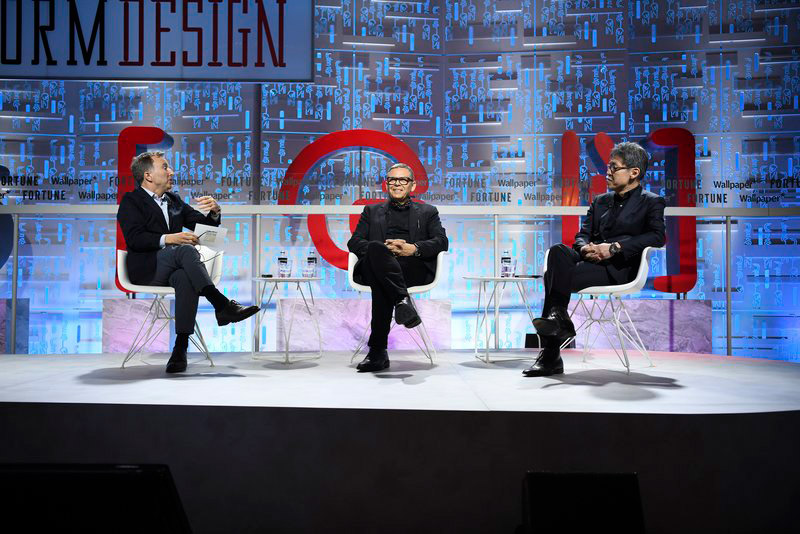設(shè)計(jì)專(zhuān)家暢談未來(lái)汽車(chē)設(shè)計(jì)

|
兩周前,,《財(cái)富》雜志和《墻紙》(Wallpaper*)雜志在新加坡共同舉辦的頭腦風(fēng)暴設(shè)計(jì)大會(huì)上,,兩位全球頂尖的汽車(chē)設(shè)計(jì)師說(shuō),汽車(chē)世界正在發(fā)生重大變化,。
前田幾雄和彼得·希瑞爾走上行業(yè)巔峰的歷史不盡相同,。來(lái)自于東京的前田是馬自達(dá)傳奇設(shè)計(jì)師前田又三郎的兒子,他追隨父親的腳步,,1982年加入了馬自達(dá),,2000年升任設(shè)計(jì)總監(jiān)。與此同時(shí),,來(lái)自于法蘭克福的希瑞爾先后擔(dān)任奧迪,、大眾、起亞的設(shè)計(jì)總監(jiān),,之后成為現(xiàn)代汽車(chē)的總裁及設(shè)計(jì)管理負(fù)責(zé)人,。
他們對(duì)汽車(chē)技術(shù)的進(jìn)步抱有相似的愿望。但他們也思考過(guò)汽車(chē)行業(yè)或許前景黯淡的想法——有人認(rèn)為共享經(jīng)濟(jì)導(dǎo)致個(gè)人交通出行行業(yè)衰落,,可能會(huì)讓汽車(chē)變成“僅僅是為大眾提供代步工具的商品,。”前田說(shuō),,“不過(guò)在馬自達(dá),,我們相信仍然會(huì)有人將汽車(chē)視作朋友、伙伴和家人。汽車(chē)是特別的,,不可替代,。”
希瑞爾指出,,汽車(chē)一直是自由的象征,,他回憶了17歲那年一拿到駕照就開(kāi)車(chē)上路的情景,何其快樂(lè)?,F(xiàn)在,,算法和人工智能似乎正在妨礙我們獲得這種自由?!坝羞@么多程序試著了解我們,,替我們做決定?!彼f(shuō),,“我們的想象力在流失?!?/p>
“過(guò)去,,如果你想從一個(gè)地方去另外一個(gè)地方,你要看地圖,。”他接著說(shuō),,“你像鴿子一樣,,感覺(jué)自己在航行。如今你只需要打開(kāi)車(chē)上的導(dǎo)航系統(tǒng),,一邊開(kāi)車(chē)一邊看著顯示器,。”
他補(bǔ)充說(shuō):“我認(rèn)為人工智能應(yīng)該扮演智能輔助的角色,。我們需要重新定義自由在這個(gè)新時(shí)代的意義,,而不僅僅是被機(jī)器娛樂(lè),被機(jī)器統(tǒng)治,。它們無(wú)法取代人類(lèi)的創(chuàng)造力[……]包豪斯經(jīng)常引用希臘哲學(xué)家普羅塔哥拉的話,,他說(shuō):‘人是衡量一切事物的標(biāo)準(zhǔn)?!鳛樵O(shè)計(jì)師,,我們必須牢記這一點(diǎn)?!?/p>
前田說(shuō):“我害怕的是,,我們一旦把注意力放在創(chuàng)新和技術(shù)上,就沒(méi)有時(shí)間去思考美,,其實(shí)必須兼而有之,?!痹隈R自達(dá),前田的口頭禪是“把汽車(chē)作為藝術(shù)”,,用美學(xué)的吸引力加深車(chē)主與汽車(chē)之間的關(guān)系,。他舉了馬自達(dá)RX Vision Coupe車(chē)型的例子。日本人欣賞四季光線變幻的美,,他們稱(chēng)之為Utsuroi(推移變化),。Vision Coupe車(chē)型即受此啟發(fā),利用汽車(chē)移動(dòng)時(shí)對(duì)光線的反射,,創(chuàng)造了一種流動(dòng)的形態(tài),,“讓汽車(chē)活了起來(lái)?!彼f(shuō),,“一輛真正漂亮的汽車(chē)可以改變黯淡的城市空間,讓城市煥發(fā)生機(jī),?!?/p>
希瑞爾認(rèn)為,從更加務(wù)實(shí)的層面考慮,,汽車(chē)的美感以及它所包含的情感元素對(duì)品牌建設(shè)也至關(guān)重要,。“如果一個(gè)品牌想活下來(lái),,就要有靈魂,,要有故事,要代表某種東西,?!彼f(shuō),“所以我不認(rèn)為,,汽車(chē)最后會(huì)變成沒(méi)有感情色彩的盒子,,而我們的設(shè)計(jì)將繼續(xù)以滿足人類(lèi)真實(shí)體驗(yàn)為中心?!保ㄘ?cái)富中文網(wǎng)) 譯者:Agatha |
There are big changes afoot in the automotive world, according to two leading car designers who spoke two weeks ago at Brainstorm Design, a conference in Singapore co-organized by Fortune and Wallpaper* magazines.
Ikuo Maeda and Peter Schreyer took different paths to the top of their industry. Tokyo-based Maeda is the son of Matasaburo Maeda, a legendary designer at Mazda, and followed his father’s footsteps to the automaker in 1982, rising to his current role as head of design in 2000. Meanwhile, Frankfurt-based Schreyer was design chief for Audi, Volkswagen, and then Kia, before becoming president and head of design management at Hyundai.
They share similar hopes for advances in car technology. But they have given thought too to bleaker prophecies—some have suggested that the sharing economy, and thus the decline of individual transport, may transform the car into “a mere commodity, mobility tool for the masses,” said Maeda. “Though at Mazda we believe that there will still be people who see their car as their friend, partner, and a member of their family. That a car is something special and irreplaceable.”
Schreyer pointed out that cars have always been symbols of freedom, recalling how he happily drove off at the age of 17 as soon as he earned his license. Now algorithms and artificial intelligence seem to be getting in the way of this freedom. “We have all these programs that learn about us and can make decisions for us,” he said. “So we are losing the culture of fantasy.”
“In the olden days, when you wanted to go from one place to another, you looked on the map,” he continued. “You had a sense for navigation like a pigeon. Nowadays you just put on the navigation system in your car and you drive, looking at the screen.”
He added: “I think artificial intelligence should be thought of as intelligent assistance. We need to redefine what freedom means in this new era, and not just be entertained and ruled by machines. They cannot replace human creativity […] The Bauhaus would often quote the Greek philosopher Protagoras, who said, ‘man is the measure of all things.’ We as designers must keep this in mind.”
“What I’m afraid of,” followed Maeda, “is that once we put our attention to innovation and technology, we don’t have any time to think about beauty. We have to think both ways.” At Mazda, Maeda’s mantra has been “car as art”—using aesthetic allure to reinforce the connection between rider and car. He cited the RX Vision Coupe as an example. In Japan, people have an appreciation for the way light changes throughout the four seasons, which they call Utsuroi. This inspired a flowing form for the Vision Coupe that leverages reflected light while the car is in motion, “to make it come alive,” he said. “A truly beautiful car can transform bleak city spaces and color the city anew.”
On a more pragmatic level, Scheyer suggested that the beauty of a car, and thus its emotional charge is essential to brand building too. “If a brand wants to survive, it needs a soul. It needs to tell a story, and it needs to stand for something,” he said. “So I don’t think we’ll ever end up with cars that are neutral boxes. We will continue to design for the human experience.” |













